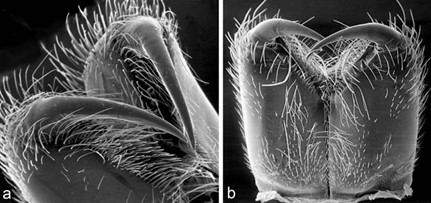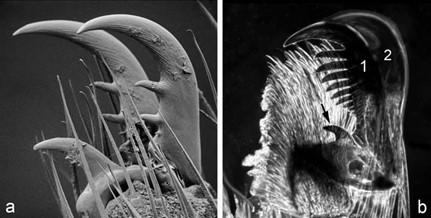博文
蜘蛛系统分类概述
||
A Sketch of Spider Systematics
At present taxonomists recognize about 40,000 spider species, which they group into 110 families (Platnick, 2009). How this diversity should be arranged into a “natural” system of classification is still very much a matter of controversy. This is best illustrated by the fact that about 20 different spider classifications have been proposed since 1900.
目前,分类学家识别出大约40,000种蜘蛛,他们将其归入110个科(Platnick,2009)。如何将这种多样性安排到一个“自然”的分类系统中,仍然是一个非常有争议的问题。自1900年以来,已经提出了大约20种不同的蜘蛛分类,这一事实最好地说明了这一点。
The order of spiders, Araneae, is usually divided into three suborders, the Mesothelae, the Mygalomorphae, and the Araneomorphae. Until recently the Mygalomorphae were referred to as Orthognatha because of the nearly parallel alignment of their chelicerae, while the Araneomorphae correspond to the former Labidognatha, which possess vertical chelicerae opposing each other (fig. 1.3). The Mesothelae represent the phylogenetically oldest spiders because they exhibit a clearly segmented abdomen, as well as several other “primitive” characters. The Mygalomorphae comprise all the tarantulas; their chelicerae lie almost parallel to each other (fig. 1.4), and their spinnerets are often reduced. More than 90% of all spiders belong to the Araneomorphae (Labidognatha). Their classification into higher taxa is still problematic. Formerly, one classification separated the Cribellatae from the Ecribellatae, based on the presence of a spinning plate (cribellum) situated in front of the spinnerets as the distinguishing character of the Cribellatae. All Araneomorphae without such a cribellum were grouped together as Ecribellatae. Nowadays it is generally assumed that all spiders were originally cribellate, and that the ecribellate spiders evolved later by a reduction or loss of the cribellum.However, several aspects remain unclear, such as possible parallel evolutions (convergences) among cribellate and ecribellate spiders. This “cribellate problem” will be discussed briefly in chapter 10.
蜘蛛的多样性与分类
截至2010年底,全世界已知蜘蛛110科3281属42055种。依照现行的分类系统,蜘蛛目(Araneae)分两个亚目,即中纺亚目 Mesothelae和后纺亚目 Opsithothelae。
中纺类蜘蛛是蜘蛛目最为原始的一类,以其纺器靠近腹部中部而得名。中纺类蜘蛛的腹部保留有分节的背板和第一腹节的腹板。该类群只包括1科,即节板蛛科 Liphistiidae,目前已知约90种。
后纺亚目,以其纺器靠近腹部后方而得名。后纺亚目又分为两个下目,即原蛛下目 Mygalomorphae和新蛛下目Araneomorphae
原蛛类主要为穴居或管栖类群,其螯牙发达,上下活动,左右近似平行排列(与螯肢同为上下活动的中纺类蜘蛛统称直螯类Orthognatha)。原蛛下目常见类群包括地蛛科Atypidae、螲蟷科Ctenizidae异纺蛛科 Hexathelidae、线蛛科 Nemesiidae、捕鸟蛛科Theraphosidae等。
自然界超过90%的蜘蛛都属于新蛛下目。新蛛下目的螯肢左右活动,故也称之为横螯类 Labidognatha。
对于新蛛类等绝大多数蜘蛛而言,眼睛的大小、数量及排列,是非常重要的科级以上分类依据。而外生殖器(雌蛛的外雌器和雄蛛的触肢器)的结构,是蜘蛛种级鉴定甚至是属级区分的最重要依据,也是动物界公认的最为客观的分类依据之一。
新蛛下目又可以根据筛器的有无,分为无筛器类Ecribellatae和有筛器类Cribellatae。在过去相当长的一段时期内,根据筛器(Cribellum)和栉器(Calamistrum)的有或无把蛛形纲蜘蛛目新蛛下目(Araneomorphae)划分为筛器类(Cribellatae)和无筛器类(Ecribellatae)两个类群,但筛器类和无筛器类蜘蛛之间的系统发育关系一直存在较大争议。可能存在趋同进化。
Among the Ecribellatae, some spider families with simple genital structures (the so-called Haplogynae) were separated from those with complex genital structures, the Entelegynae (fig. 1.5). This classification dates back to Eugène Simon’s “Histoire Naturelle des Araignées” (1892–1903). Over the past years, however, several arachnologists have voiced the opinion that the Haplogynae are not really a homogenous group (Brignoli, 1975; Lehtinen, 1975; Platnick, 1975; Platnick et al., 1991). Some haplogynes have quite complex genital structures (Burger et al., 2006a, b), and some haplogynes seem to be secondarily reduced entelegynes. Despite all these arguments, there are still some families that represent “classical” haplogyne spiders, such as theScytotidae, the Pholcidae, and the Dysderidae.
在无筛器类中,一些科的蜘蛛是简单生殖器类,与那些复杂生殖器类相区分。这个分类要追溯到西蒙的“Histoire Naturelle des Araignées” (1892–1903)。然而,在过去的几年里,几位蛛形学家已经发表了这样的观点,即简单生殖器类并不是一个真正的单系群。一些简单生殖器类的蜘蛛具有相当复杂的生殖结构,并且一些简单生殖器类群其实是复杂生殖器的次级缩减。尽管有这些争议,仍然有一些科代表了典型的简单生殖器类群,例如花皮蛛,幽灵蛛,石蛛科。

Figure 1.3 Movement of the chelicerae in orthognath (a) and labidognath spiders (b). (After Kaestner, 1969.)直螯类和横螯类 螯肢的移动方式

Figure 1.4(a) Orthognath chelicerae (Brachypelma, ventral view), having a roughly parallel alignment. (b) labidognath chelicerae (Tegenaria, posterior view), opposing each other.a 直螯类,螯牙几乎是平行的;b 横螯类,螯牙是相对的

Figure 1.5 Comparison of the female reproductive tracts in (a) haplogyne, and (b) entelegyne spiders. Gray arrows indicate the direction of sperm transfer into the spermathecae (Rec), black arrows denote the sperm transfer toward the egg cells prior to fertilization. Cd = copulatory ducts, F = fertilization duct, Ut = Uterus. (After Uhl et al., 2009.)
比较简单生殖器类和复杂生殖器类,简单生殖器对后交配的精子有利,复杂生殖器对先交配的有利。
Following Simon’s classification, the Entelegynae were further divided into Dionycha and Trionycha, depending on whether the legs have two or three tarsal claws (fig. 1.6). Although this subdivision also became questionable, there is again some justification to maintain at least some classical Dionycha, such as the Salticidae, the Clubionidae, and the Thomisidae.
根据西蒙的分类体系,根据腿上是否有两个或三个跖爪,复杂生殖器类被进一步划分为两爪类和三爪类(fig.1.6)。虽然这种划分也是有问题的,但还是有一些分类体系会保留此规则,至少有一些经典的两爪类,如跳蛛科、管巢蛛科和蟹蛛科。

Figure 1.6 (a) Ancient spiders probably had three tarsal claws on each leg, as seen here in the “primitive” spider Liphistius. (b) In some spider families, the Dionycha, the middle claw was supposedly lost. However, a reduced middle claw (arrow) is often still present, like in this tarsus of a young jumping spider. The two main claws (1, 2) are serrated like a comb.
图1.6(A)原始蜘蛛类群的每条步足上可能有三个睑板爪,就像这里看到的“原始”蜘蛛Liphistius。(B)在一些蜘蛛科中,两爪类的蜘蛛的中爪被认为丢失了。然而,缩小的中爪(箭头)经常仍然存在,就像这只小跳蛛的一样。两个主爪(1、2)呈梳状锯齿状。
Since the following text will often refer to certain spider families, the main families and their systematic position are listed below (for more details of modern spider systematics, see chapter 10). 常见的蜘蛛科目
Order Araneae 蜘蛛目
1. Suborder Mesothelae (1 family) Family Liphistiidae (85 species) 中纺亚目 节板蛛科
2. Suborder Mygalomorphae (Orthognatha) (15 families) 原蛛下目
Family Atypidae (45 species) 地蛛科
Ctenizidae (120 species) 螲当科
Dipluridae (180 species) 长尾蛛科
Theraphosidae (900 species) 捕鸟蛛科
3. Suborder Araneomorphae (Labidognatha) (90 families) 新蛛下目
Family Dysderidae (560 species) 石蛛科
Pholcidae (1000 species)
Scytotidae (220 species)
Amaurobiidae (750 species)
Dictynidae (550 species)
Eresidae (100 species)
Clubionidae (560 species)
Gnaphosidae (2100 species)
Salticidae (5200 species)
Thomisidae (2100 species)
Lycosidae (2350 species)
Pisauridae (340 species)
Oxyopidae (420 species)
Agelenidae (500 species)
Araneidae (3000 species)
Linyphiidae (4300 species)
Theridiidae (2300 species)
Uloboridae (260 species)
https://wap.sciencenet.cn/blog-3411995-1259711.html
上一篇:黑腹果蝇作为捕食性天敌的人工猎物的营养品质
下一篇:捕食的温度依赖性:随着气候变暖,捕食者的杀伤率和猎物消耗量增加
全部作者的其他最新博文
- • 实验2 体格检查
- • 实验1 牛乳掺伪的检验
- • 教学演练设计
- • [转载]怎样养成好习惯
- • 漏斗蛛
- • [转载]你知道你有5种不同的食欲吗?